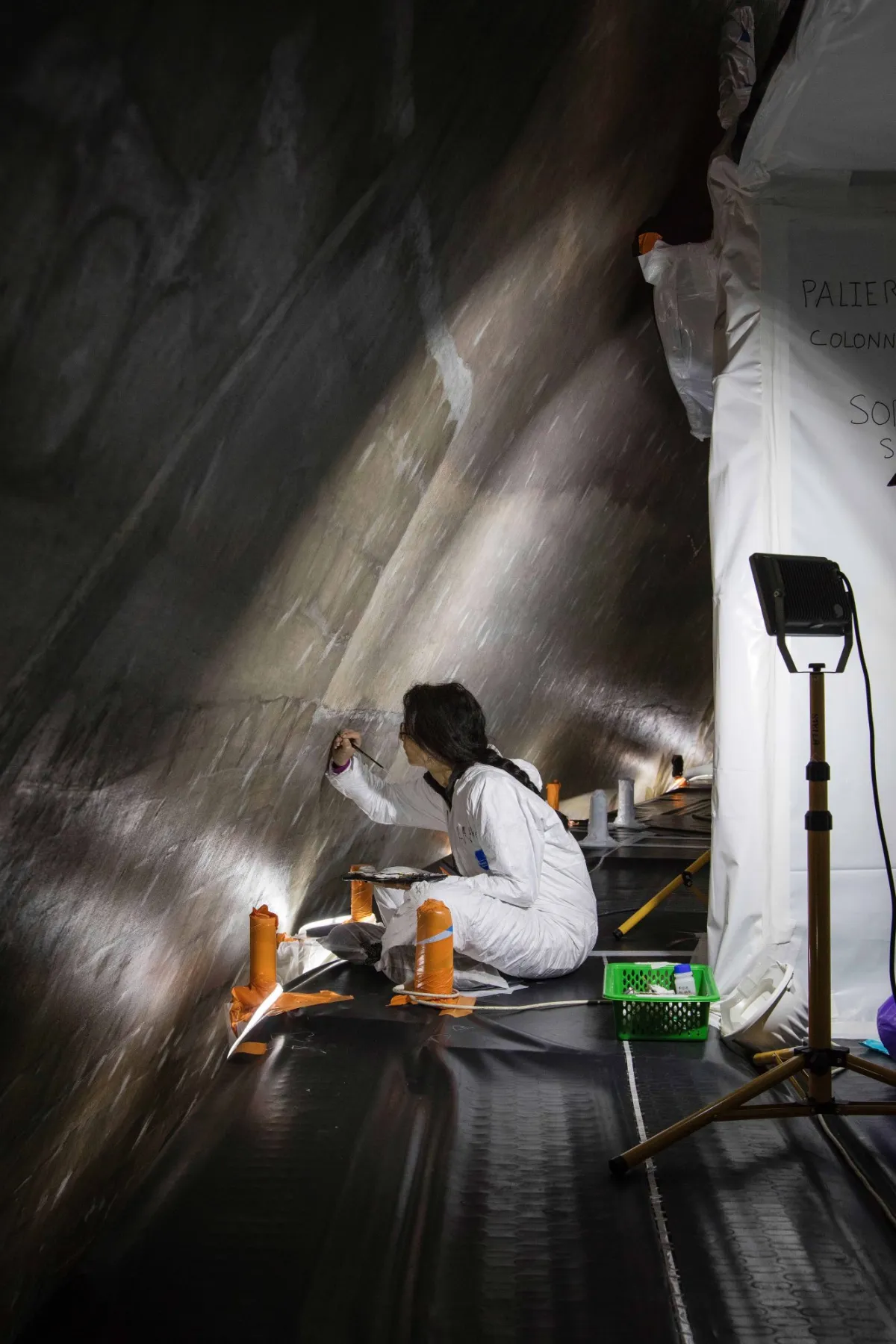
Restoration of the "panorama du commerce"
Stepping inside the Bourse de Commerce, visitors immediately look up at the dome, towering forty metres above their heads. There, they discover the immense painting created in 1889, spanning a full 360 degrees. In this article, we look at the work behind this exceptional restoration campaign.
Guillaume Picon: How did you feel the first time you saw the decor that adorns the top of the Bourse de Commerce?
Alix Laveau (curator with the Direction des Musées de France): I discovered the Bourse de Commerce before renovation work began. I was impressed by the scale of the paintings: a panorama measuring 140 metres long by 10 metres high, or 1,400 square metres. It seemed endless! Beginning the restoration campaign didn’t lessen that emotional reaction. Scaffolding was built to enable me to work at a height of twenty metres: I was only a few inches away from the paintings. This proximity was overwhelming, intoxicating.
I was impressed by the scale of the paintings: a panorama measuring 140 metres long by 10 metres high, or 1,400 square metres. It seemed endless!
What do the paintings depict?
They deal with the progression of modernity in France through trade and commerce with countries around the world. In an article about the inauguration of the Bourse de Commerce, the newspaper Le Temps, in its issue dated 21 November 1889, hailed this decor a “panorama of commerce.” 1889 was also the year of the Exposition Universelle, during which France presented two iconic monuments: the Eiffel Tower and the Bourse de Commerce. France wanted to show itself off in “its finest attire,” and this decor is one of its best!
How was this panorama perceived at the time?
Public opinion, as recorded in the press, seemed rather divided. A few critics had reservations; others were full of praise. For instance, historian Charles Bivort, in a work devoted to the building’s history published in 1889, wrote that, “All these paintings, connected by a blue expanse of sky, are in perfect harmony and produce a stunning effect. The elevation of the cupola is such that the people depicted had to be rendered on a huge scale in order to be visible: their heads, in the foreground, are over half a metre wide.” Nonetheless, many critics referred to the lack of coherence of the overall composition.
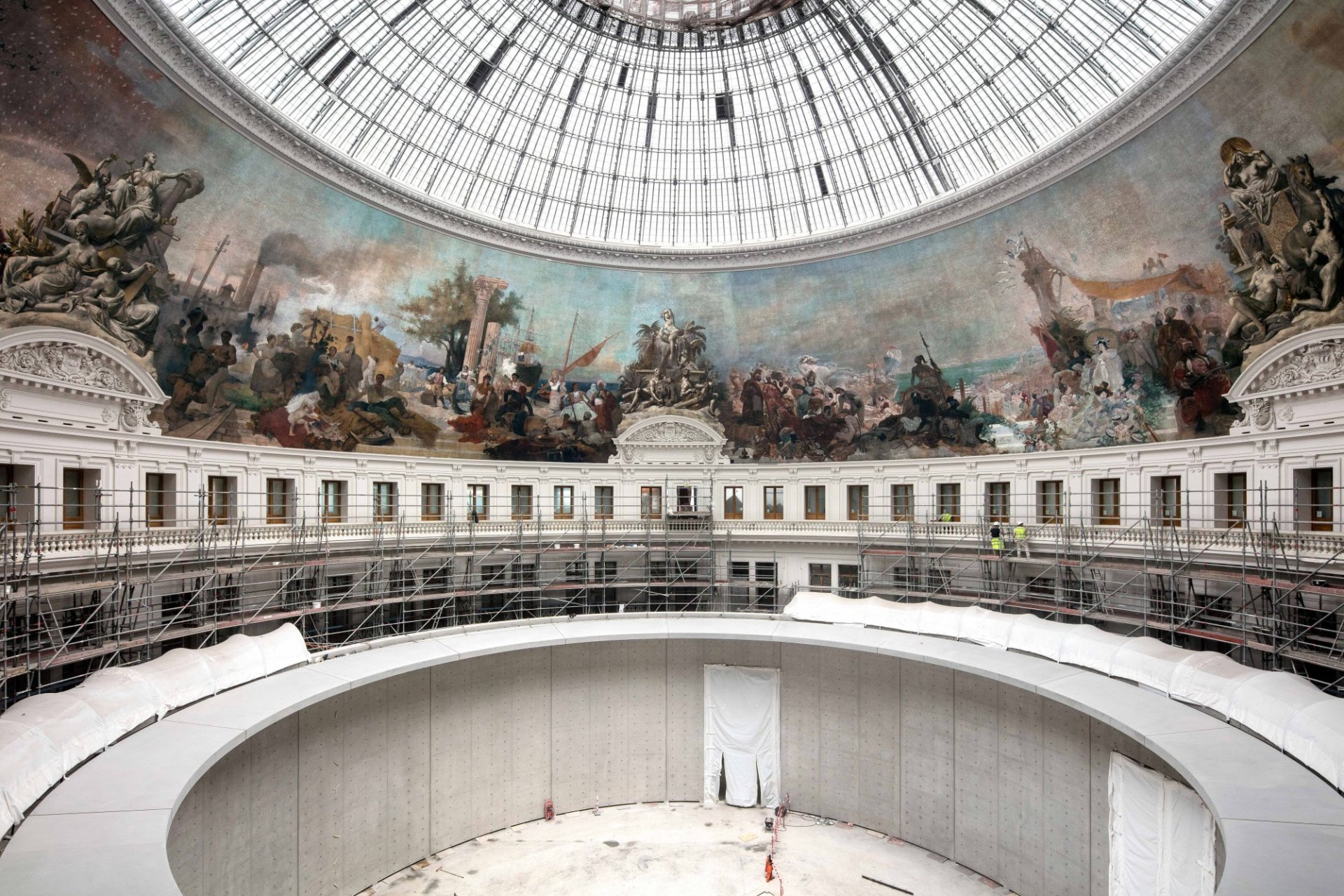
Who painted this “panorama of commerce”?
The panorama is the work of not one, but five artists, which explains the lack of coherence mentioned in some newspaper articles. Four of them represented commerce in a given part of the world: Évariste-Vital Luminais was assigned America; Désiré-François Laugée, Russia and the North; Georges-Victor Clairin, Asia and Africa; and finally, Hippolyte Lucas, Europe. In between these scenes, Alexis Mazerolle, who supervised the project, added allegories of the continents and regions depicted by the individual artists, in each of the four cardinal directions: Europe is represented by the arts and architecture; Africa by a lion and the hunt; Asia and the Orient by a hookah and elephants; and the North by a polar bear. This large, detailed composition takes viewers on a visual journey across the world.
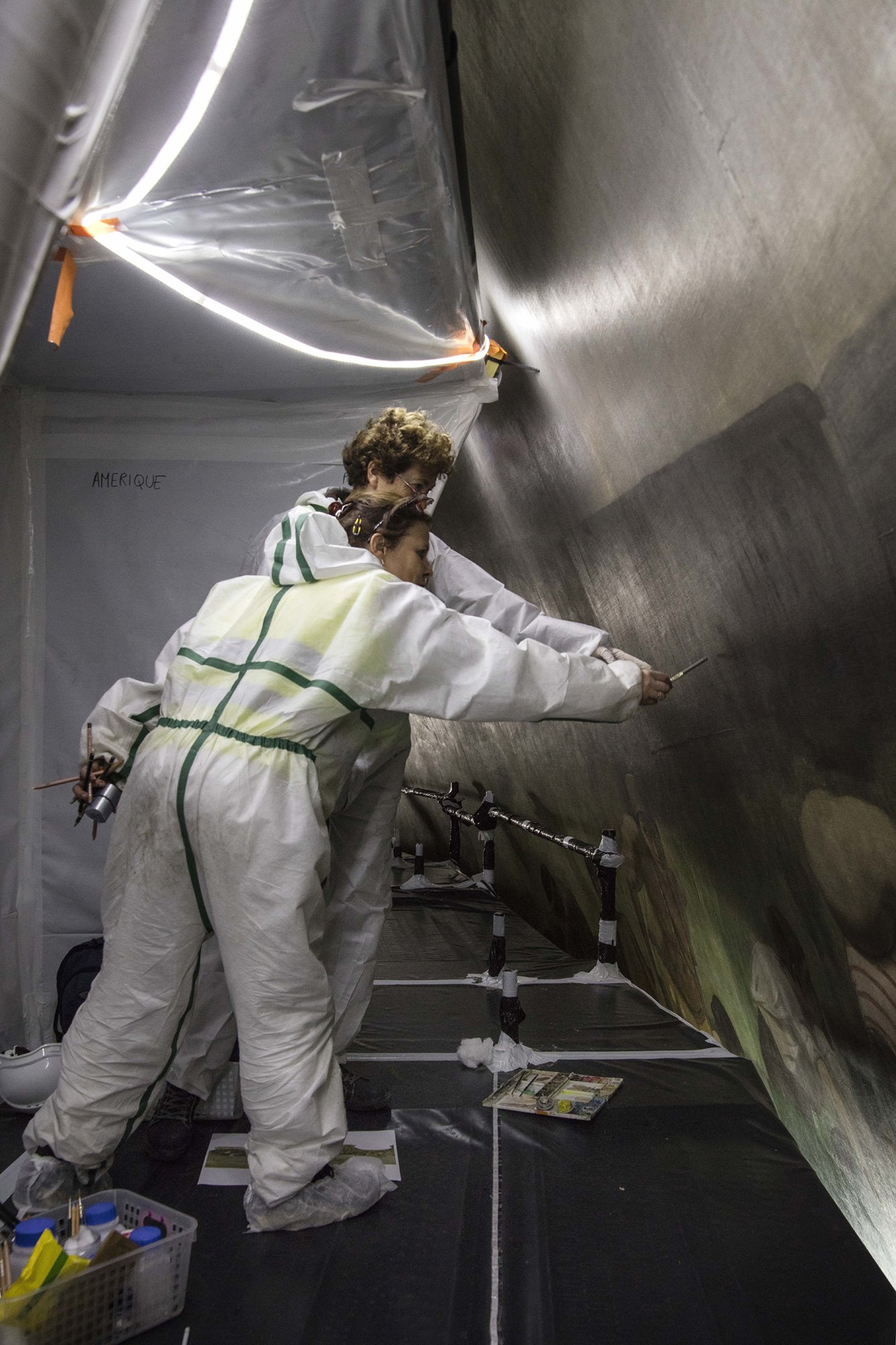
Today these painters are little known, or not at all. How were they considered by the art world in the late nineteenth century?
Paris became a modern city under Napoléon III. New infrastructure and monuments were built, many of which were decorated. Artistic production soared. Twentieth-century critics were generally scornful of the decorative paintings created during the nineteenth century, even when those were of a high calibre. Yet, visitors today are amazed when they discover the decor painted by Isidore Pils for the monumental staircase of the Opéra Garnier. Clearly this type of painting is still awe-inspiring!
The artists who worked on the dome of the Bourse de Commerce were known at the time, even renowned. Georges Clairin studied in the studio of François Édouard Picot. He was one of the “Orientalist” painters and was chosen to participate in the decoration of several public monuments, such as the staircase and foyer of the Opéra Garnier, the ceilings of the Hôtel de Ville and the Sorbonne. After Mazerolle passed away in May 1889, Clairin supervised the completion of the work at the Bourse de Commerce.
Alexis Joseph Mazerolle, the backbone of the team, was also the most academic painter amongst them. He created decors for many important theatres, including the Opéra in Paris. He had an international clientele, with commissions in Naples and New York.
Like Clairin, Désiré Laugée studied under François Édouard Picot; he was also a poet and was friends with Victor Hugo. He was interested in depicting the countryside, which aligned him with Naturalism. Laugée created some important decors: at the Palais du Luxembourg, the Église Sainte-Clotilde, and the Hôtel Continental, built by Henri Blondel, the same architect responsible for the Bourse de Commerce!
Évariste-Vital Luminais is considered a history painter, and as such, an academic artist. His depictions of the Gauls and the Middle Ages were part of a new iconography of the country’s history, disseminated in textbooks under the Third Republic.
Finally, Hippolite Lucas, a student of Luminais, was the youngest member of the group. He painted large decors for the Casino of Monte Carlo, the convention centre and oceanographic museum of Monaco, as well as the ceilings at the Préfecture du Rhône.
How did the work progress?
Archival material pertaining to the organization of the site and the relationships between the artists is limited. Some sketches by Lucas and Luminais are preserved in the collections of the Petit Palais and the Musée d’Orsay.
The artists created their paintings on several lengths of linen or hemp canvas in their individual studios. These were then recut, pasted together, and attached to the walls with white lead as an adhesive (marouflage). The canvases were joined together in situ by their creators.
Had the panorama ever been restored before now?
The panorama was restored a first time in 1995, and a second time, from 2010 to 2013, but only in certain sections, following a fire.
In what condition were the paintings before your intervention?
These had grown dirty over time, developing a dull, off-white layer that altered the colours of the decor and affected the relationships between the light and shaded areas. The entirety of the painted canvases had become very fragile; the binder used in the paint had lost its adhesive power. Unfortunately, this deterioration had led to some very visible losses of paint. Previous touch-ups and more large-scale restorations had been transformed by the intense ultraviolet light and the temperatures of the air-conditioned Bourse over the past twenty years.
Fortunately, the sections where the canvas had become unglued from the wall were rare. Last but not least, there was another rather significant anomaly that was difficult to correct: ghosting. This consisted of “stains” along the metal frame of the cupola. These stains were produced by dust, attracted by the magnetic pull of the metal structure. When you are on the scaffolding and looking at the paintings up close, these stains become almost invisible. One of the more challenging tasks we undertook was to create a map of these patterns, by means of photographs, so that we could locate and remove them.
What constraints did you have to keep in mind?
There were two important considerations to bear in mind: the allocated budget and the timeframe within which we had to complete the work. Given our initial assessment of the paintings and the panorama’s exceptional scale, we estimated, correctly, that the project would require a great deal of time and resources. There was the additional problem of lead pollution from the paint used in the late nineteenth century; and furthermore, the lack of space was problematic: because the scaffolding was so narrow, it was impossible to take a step back and have a more global view of the composition. The restoration of the panorama was just one aspect of the larger transformation of the entire building. The noise of the machines, the dust of the construction work, the cold, the heat, etc., all of these factors made our work more difficult.
The restoration of the panorama was just one aspect of the larger transformation of the entire building. The noise of the machines, the dust of the construction work, the cold, the heat, etc., all of these factors made our work more difficult.
How was the restoration work organized?
We divided the work into three phases: cleaning, an aesthetic intervention, and a final harmonization of the whole. I recruited a team of twenty-four restorers, divided into six work groups. The entire team consisted of people with whom I had worked before. We share the same philosophy of restoration and follow the same code of ethics. It was important for me to keep the bigger picture in mind so that I would not get lost in the details of the decor. I needed to make sure that our work, particularly the final result, was uniform. Details pertaining to the “ideal” condition of the panorama, to the previous restoration, and to this current one, were meticulously recorded in a technical document that allowed us to proceed quickly and effectively.
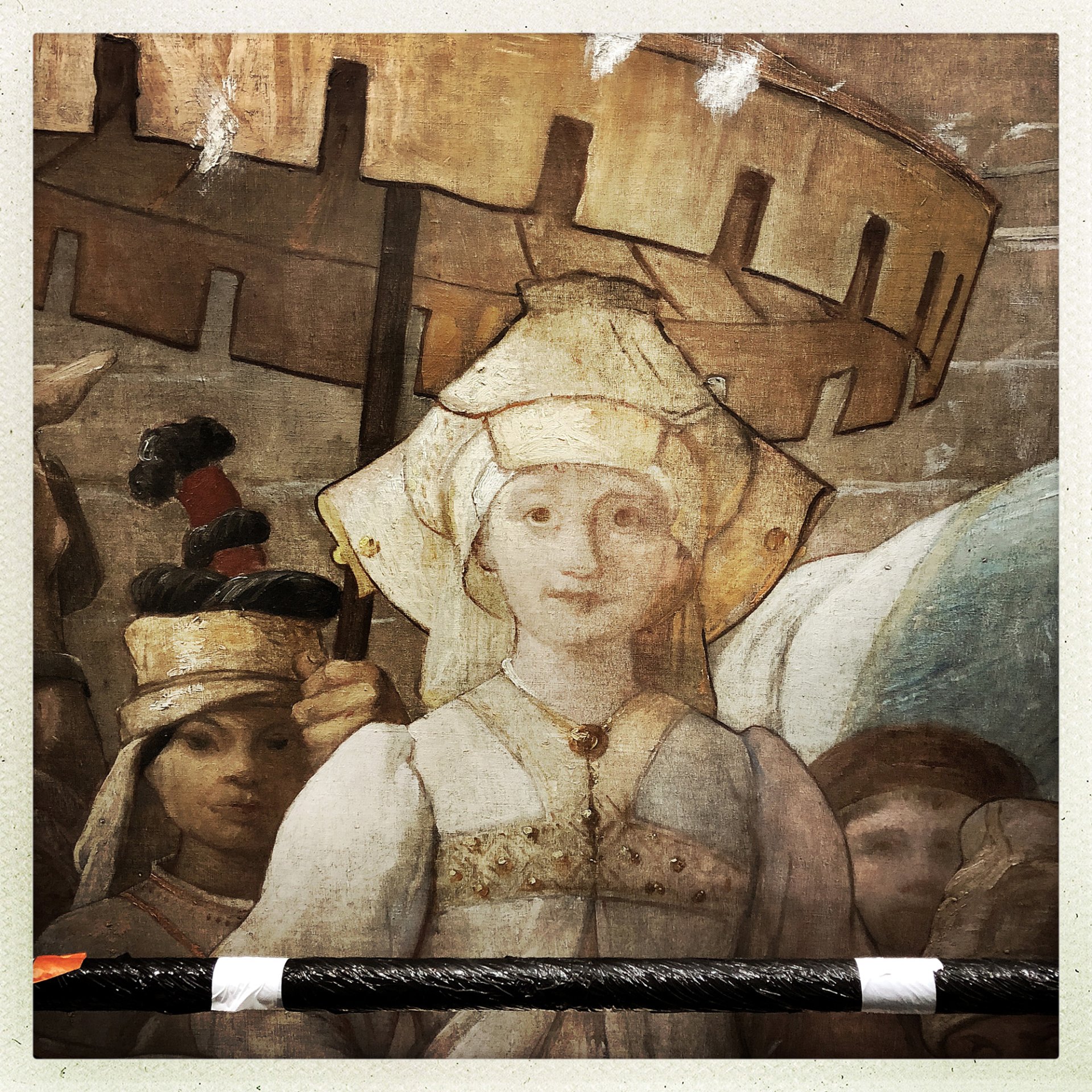
Did you make any discoveries during the restoration process?
The observations I have just mentioned made it possible to understand the stages in the realization of this large-scale decor. The first relatively successful figured compositions were done on pre-prepared industrial canvases, with a white undercoat, and were painted in the workshop. Overall, the sections of sky remain fairly fluid and were not the subject of a great deal of work, except for that of the Far North. Then, the upper sections corresponding to the sky were attached to the wall using white lead. The dimensions of these sections measure approximately five by four metres. The first canvas was then pasted in the centre. The others were placed afterwards, partially covering the first-laid piece. Cutting around the sections and the joins was done by hand, more or less regularly.
The canvases with compositions of figures came later. Their height varies between five and six metres. The various figures were cut out and then pasted, requiring numerous adjustments, superimpositions, and re-cuts. There were notches made to readjust the strips and ensure that these were properly pasted. This suggests the intervention of marouflage specialists. The paintings by Mazerolle were executed in his studio on a single strip of canvas. Their cutting is very precise, carefully following details like toes or the leaves of plants. These strips are in the format of a square measuring six metres on each side, and each square ensures the intersection between the two continents that surround it. Small painted strips were used to cover any gaps between sections.
The entire composition was touched up on site, after the marouflage process by the artists who intervened a last time, either to harmonize the sections, or to finalize unfinished parts.
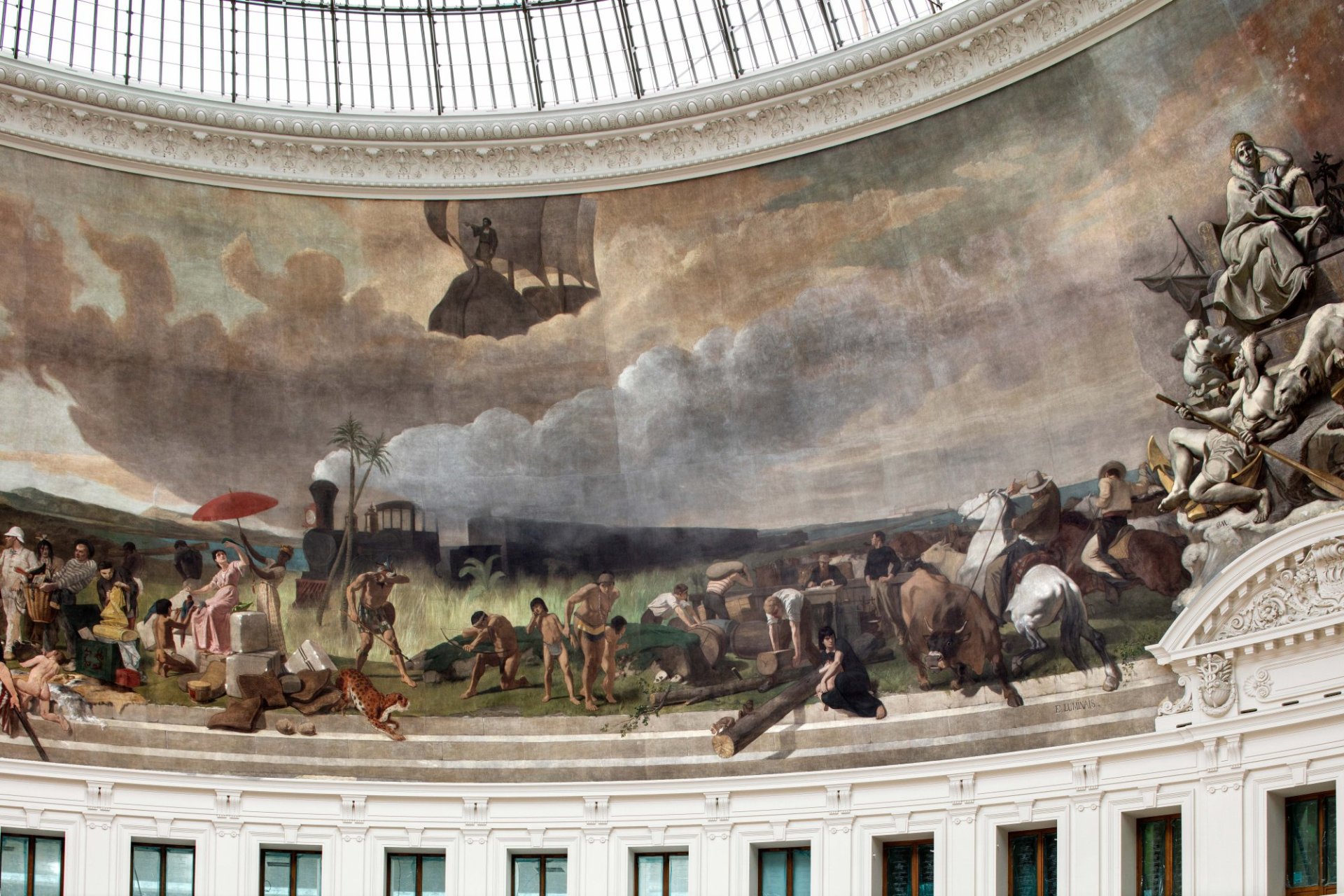
Three months after completion of the restoration, how do you feel about the Panorama du Commerce?
This restoration, a crucial component of Tadao Ando’s project for the Pinault Collection, makes it possible to see the mural paintings in a way that has never been possible before. From the walkway created at the top of Ando’s central cylinder, visitors will be closer to the Panorama than their nineteenth-century forerunners had been. Our goal for this restoration was exactly that.
Allow me to quote an amusing movie reference by way of conclusion. In Marco Ferreri’s Don’t Touch the White Woman! (1974), the character played by Philippe Noiret looks up at the dome of the Bourse de Commerce and says: “Beautiful fresco, isn’t it? It’s our Sistine Chapel!” I couldn’t think of a better compliment.